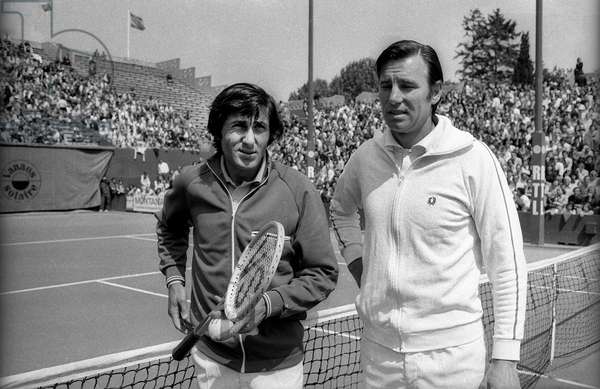“The greatest thing about the French,” said John Newcombe, “is that it’s so bloody hard to win.”
The greatest thing about Ilie Năstase was that he made everything look so easy.
The 26-year-old Romanian was, by all accounts, the greatest clay-court player on tour. He had cruised through six rounds in Paris without dropping a single set. Only one man–Roger Taylor, in the quarter-finals–earned a set point against him. Năstase erased it with a sharply-angled backhand that few other men would’ve dared attempt.
The surprise of the tournament was the other finalist: Yugoslavia’s Niki Pilić. Pilić had begun the fortnight in the news for other reasons, after his national federation suspended him for missing a Davis Cup tie. The ILTF allowed him to play the French and delayed a decision on his appeal to June 1st. “Somebody would be embarrassed,” wrote the New York Times, “if by then Pilić was in the final.” Oops.
Pilić, a 33-year-old lefty who hadn’t reached the quarter-finals of a major since 1967, took advantage of a soft draw, then turned in the match of his life to defeat Adriano Panatta in the semi-finals. “He must have been annoyed at me for serving so well,” said the southpaw. “The way I played today, I could beat anyone.” Even Năstase?
A week of rain pushed the schedule back two days, and the final was at last contested on Tuesday, June 5th. The Romanian came out tense, and he dropped the first three games. The embattled Pilić appeared capable of an enormous upset.
“I can always tell after the first two or three games how I will play,” Năstase told Laurie Pignon of the Daily Mail. “The feel of the ball on the racket; the way my body moves, and if my eyes take in everything. When I play badly I get cross with myself for I know I am not giving the people what they have paid to see.”
At the second change of ends, Ilie must have known something that wasn’t yet apparent to the rest of the stadium. He unleashed backhand after backhand to win six games in a row and 11 of the next 12. When Pilic shifted tactics and attacked his forehand in the third set, Năstase hit a string of winners off that wing as well. Final score: 6-3, 6-3, 6-0.
Pilić might have repeated the post-match summary of Năstase’s semi-final victim, Tom Gorman: “Not a good enough volley. Not a good enough second serve. Too good an opponent.”
One French newspaper called the championship match “A Brigands Final,” referring to Pilić’s limbo and Năstase’s on-court antics. The Romanian often veered between charming character and combative cad, but on this day, he kept the theatrics in check. He struck an off-key note only after the match, when he told the crowd that his US Open title the previous year had meant more. With the French title in the bag, he was ready to take on Wimbledon, where he had come within two games of victory the year before. His idol, Manolo Santana, had ridden clay-court expertise to a title at the All-England Club, and Năstase was ready to do the same.
* * *
As if an 80-minute drubbing wasn’t bad enough, Pilić’s day got worse after the match. The ILTF delivered its judgment. It wouldn’t uphold the entire nine-month suspension sought by the Yugoslavian federation, but it assessed a one-month ban. That would keep the Croatian out of both the Italian Open–already underway in Rome–and Wimbledon.
Astute observers recognized that this was only the beginning. David Gray of the London Daily Telegraph reported various retaliatory proposals mooted by members of the Association of Tennis Professionals, the new players’ union. The men could boycott the Davis Cup, or perhaps they would no longer cooperate with the ILTF’s tournament schedule, essentially unleashing an outright war between the old guard and newer pro circuits like Lamar Hunt’s World Championship Tennis.
Gray felt that the ILTF had overplayed its hand. “They still apparently feel that they can control the destinies of the players without proper consultation,” he wrote. “They are likely to find that they are living in the past.”
* * *
This post is part of my series about the 1973 season, Battles, Boycotts, and Breakouts. Keep up with the project by checking the TennisAbstract.com front page, which shows an up-to-date Table of Contents after I post each installment.
You can also subscribe to the blog to receive each new post by email:
